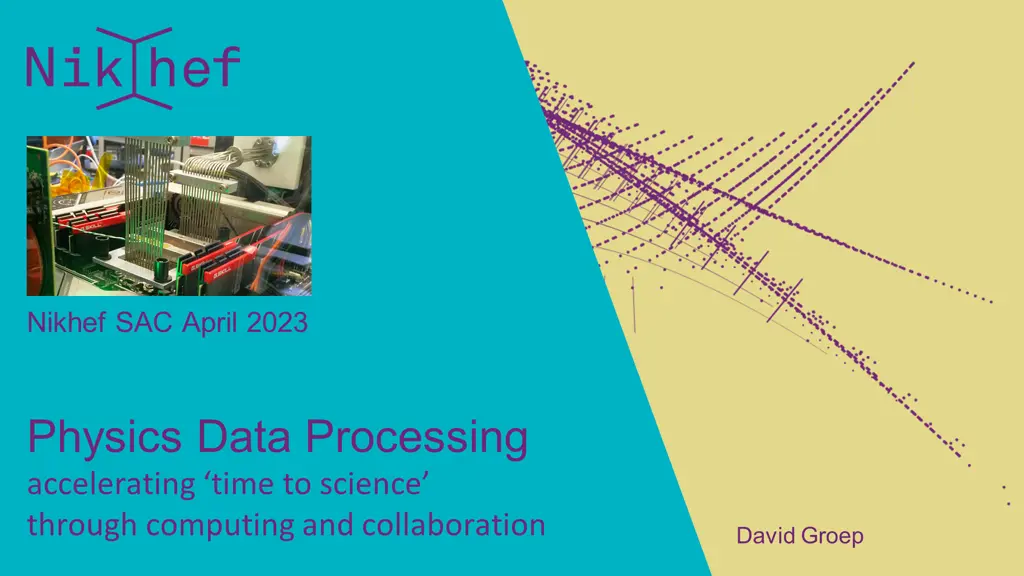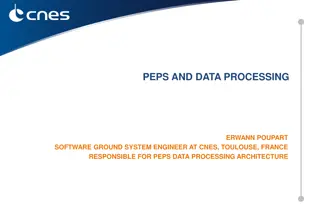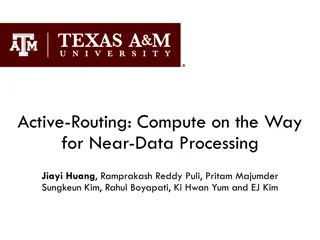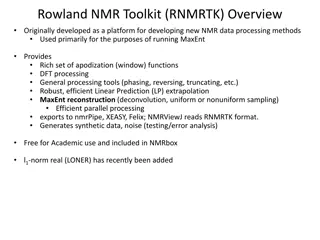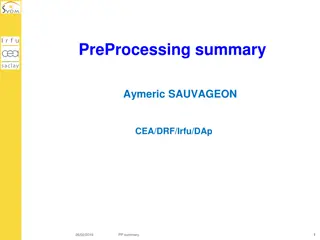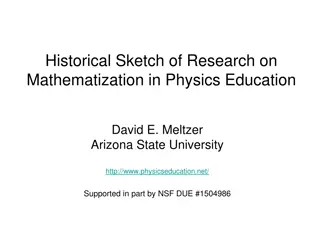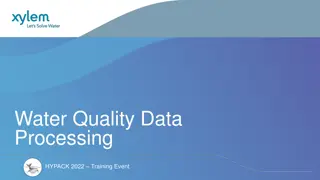Physics Data Processing
The efficient computing and accelerated results in physics data processing, algorithmic design patterns, software infrastructure, and trusted collaboration. Discover the three pillars of Nikhef and the infrastructure for research.
- physics data processing
- computing
- collaboration
- algorithmic design patterns
- software infrastructure
- trusted collaboration
- research infrastructure
- efficient computing
Download Presentation

Please find below an Image/Link to download the presentation.
The content on the website is provided AS IS for your information and personal use only. It may not be sold, licensed, or shared on other websites without obtaining consent from the author. Download presentation by click this link. If you encounter any issues during the download, it is possible that the publisher has removed the file from their server.
E N D
Presentation Transcript
Nikhef SAC April 2023 Physics Data Processing accelerating time to science through computing and collaboration David Groep
The three pillars of Nikhef Physics Data Processing Algorithmic design patterns and software Infrastructure, network & systems co-design R&D Infrastructure for trusted collaboration designing software for (GPU) accelerators, new algorithms, high-performance processors software design patterns for workflow & data orchestration trust and identity for enabling communities managing complexity of collaboration mechanisms securing the infrastructure of our open science cloud building research IT facilities co-design & development big data science innovation research on IT infrastructure people: 3.6 FTE (2.6 staff + 1 postdoc) 2 + ~ 7.5 FTE DevOps and research engineers from the Nikhef computing technology group
Efficient computing and accelerated results FASTER: computing for HL-LHC & 4D reco LHCb s Allen full-GPU trigger for HLT1 - now adding HLT2 and CPU NN implementations NLeSC GPU acceleration in LHCb and parallel inference with ONNX+tensor ML libraries R&D roadmap for hybrid computing link to infrastructure innovation & engineering with vendors alternative architectures: non-x86, watercooling, GPU+FPGA, hybrid dies scaling and validation , collaboration with computer science (SLICES-RI) & ML algorithms (@UM + RU) For the long term: Quantum Computing algorithms exploration in collaboration with our experiments (notably LHCb and GW), QuSoft (CWI, UvA, et al.), SURF, and IBM (Z rich) via Maastricht personal expectation: production use far away (>2035?), but work on algorithms, even if ultimately not QC, very interesting anyway Image: LHCb s Allen team: Daniel Campora (Nikhef & UM), Roel Aaij (Nikhef), Dorothea vom Bruch (LPNHE) (source: LPNHE). Graphs: Allen inference event rate vs batch size (NLeSC) https://github.com/LHC-NLeSC/run-allen-run 3 PDP: accelerating time to science through computing and collaboration
Infrastructure for Research High-through compute (HTC) + HT storage National e-Infrastructure coordinated by SURF NL-T1, IGWN, KM3NeT, Xenon, DUNE + WeNMR, MinE, Stoomboot local analysis facility + IGWN cluster & submit node ~ 12 000 cores, 13 PByte storage installed, with pretty competitive TCO! Occupancy: NDPF DNI processing facility. Faster processors (AMD Rome) allows processing in fewer cores using less power 4 PDP: accelerating time to science through computing and collaboration
Common solutions are essential for our national facility We promote alignment of general purpose e-Infrastructure and use by experiments (LHC, GW, KM3NeT, DUNE, Xenon, ...) common solutions since bespoke systems for each experiment do not scale for Nikhef (NL) needed for both efficient resource sharing and importantly: for our DevOps people IGWN use of NL DNI infrastructure at NIKHEF & SURF 4-11 April, 2023 NL DNI Nikhef + SURF Continuation of our long-term strategy - from EU DataGrid onwards: drives collaborative efforts we work with for identity management and common protocols: ACCESS-CI and CILogon (US) which are key players for LIGO, DUNE, and US-ATLAS common processing framework development (e.g. together with KM3NeT in its INFRADEV project) Data on Tue April 11th2023 from the OSG accounting for the LIGO VO for past week (with also SURFsara fully in production) https://gracc.opensciencegrid.org/d/9u1-Q3vVz/cpu-payload-jobs?orgId=1&var-ReportableVOName=ligo&var-Project=All&var-Facility=All&var-Probe=All&var-interval=1d&from=1680566400000&to=1681257600000 5 PDP: accelerating time to science through computing and collaboration
Innovation on infrastructure Network systems integration Storage throughput & DPUs Systems design and tuning early engineering engagement with vendors to build us suitable systems co-design of our national HPC systems ( Snellius ) data-intensive compute with DPUs. Or on-NIC FPGAs? next-gen networks: >800Gbps (and 400G to CERN) Image: Minister of Economic Affairs M. Adriaansens launched the Innovation Hub with Nikhef, SURF, Nokia and NL-ix, January 2023. Composite image from https://www.surf.nl/nieuws/minister-adriaansens-lanceert-testomgeving-voor-supersnelle-netwerktechnologie 6 PDP: accelerating time to science through computing and collaboration
Our science data flows are somebody elses DDoS attack Image sources: belastingdienst.nl, rws.nl, nu.nl, werkentegennederland.nl 8 PDP: accelerating time to science through computing and collaboration
Infrastructure for Collaboration Target high-impact specialized areas, bridging policy & technical architecture for AAI & OpSec authentication & authorization for research collaboration AARC project & community, GEANT GN5, REFEDS & eduGAIN, EOSCFuture, TCS & RCauth.eu, and planned: EOSC Core, AARC-TREE, EOSC-Q, policy for interoperability for data protection, seamless service access, single-click acceptable use continuous technical evolution driving IGWN, WLCG in line with the AARC BPA and global RIs embedding of data processing needs of our experiments in the EOSC landscape EOSC Interoperability Framework EOSC-A (AAI-TF), EGI, GEANT community 9 PDP: accelerating time to science through computing and collaboration
Collaboration: Research Data Management beyond FA FAIR for live data and large volumes, shifting gears towards the I and R not that many disciplines with really voluminous data so nationally join forces with those who do: ASTRON (SRCnet), KNMI (earth observation, seismology) work with those who care about software to bring data to life: NLeSC, 4TU.RD/TUDelft, CWI, and with those who ensure the infrastructure: SURF for our own analyses and the local (R&D) experiments we work towards continuous deposition of re-usable data and software NWO Thematic Data Competence Centre for the Natural and Engineering Sciences develop Djehuty RDM repository software link to Stoomboot analysis cluster storage research data management is just part of a good science workflow 10 PDP: accelerating time to science through computing and collaboration
Infrastructure R&D and system co-design PDP strategic directions and their supporting projects New initiatives and projects strengthen the strategic areas ensure continuity of research and infrastructure Research Software & Acceleration BDSI planned project pathways include GN5-*, AARC-TREE, EOSC-Q, EOSC Core, LHC4D Roadmap, Public partner R&D engagement AMD, Nokia, NVidia/MLNX, IBM, NL-ix, Dutch national government Infrastructure for Collaboration 11 PDP: accelerating time to science through computing and collaboration
Where do we plan to go from here? Strategic focus areas for ~2030 algorithm design patterns for processing & analysis infrastructure design for multi messenger trusted global collaboration and data management on this near term timescale accelerators (such as GPUs and hybrid computing) also in off line processing and analysis much more machine learning needing both learning and inference network bandwidths > 1Tbps, and to more destinations (SURF, CERN, ESnet, TENET, ) exploration of distributed processing (integrating trigger, processing, networking, and opportunistic capacity) changing collaboration technologies: industry augmenting our bespoke models significant changes in service delivery ( data lakes , multi user workflow systems, science networks, EOSC) and in due course, we ourselves and as a community will change executable papers, notebooks for all Research Environments, beyond -Open-Science workflows, mobile first research computing, and who knows what s more to come? 12 PDP: accelerating time to science through computing and collaboration
Because we can does not mean its the scalable way LCO2 cooling of an AMD Ryzen Threadripper 3970X [56.38 C] at 4600.1MHz processor (~1.5x nominal speed) sustained, using the Nikhef LCO2 test bench system (https://hwbot.org/submission/4539341) - (Krista de Roo en Tristan Suerink)
Physics Data Processing towards results unconstrained by computing David Groep davidg@nikhef.nl https://www.nikhef.nl/~davidg/presentations/ https://orcid.org/0000-0003-1026-6606 Event
Policy development in ICT and our collaborative values Our Research Infra (and Open Science) needs a collaborative values framework frequently threated by increasingly corporate approach to ICT services continuous remedial action needed at many levels: from European Commission and EP, down to even our own centralized national institutes organization Continued vigilance on IT infra is part of PDP programme to keep our research ICT infrastructure open, e.g. through: reviewed & improved NIS2 directive, with our Opinion taken up by the EP; watch carefully and continuously NWO s push to corporate IT and its impact on academic integrity & freedom; promote trustworthy federated access via AARC (globally), SRAM (our SURF national scheme), promote trust & identity with our university partners build scalable security solutions rather than pay corporate ISO tick-box providers luckily many times in collaboration with GEANT, JISC, STFC, EGI, and our peer institutes in NL https://doi.org/10.5281/zenodo.4629136 15 PDP: accelerating time to science through computing and collaboration
